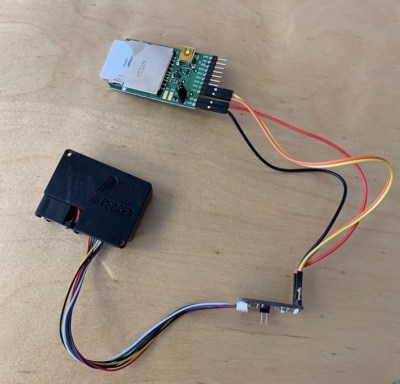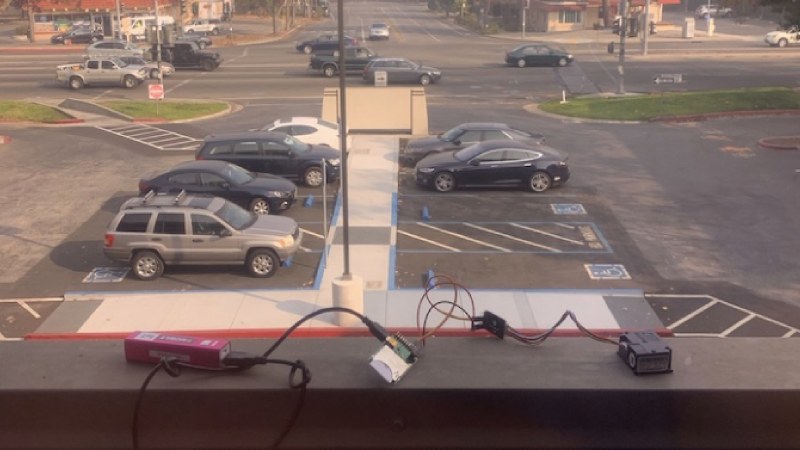The wildfires in California are now officially the largest the state has ever seen. Over 50,000 people have been displaced from their homes, hundreds are missing, and the cost in property damage will surely be measured in the billions of dollars when all is said and done. With a disaster of this scale just the immediate effects are difficult to conceptualize, to say nothing of the collateral damage.
 While not suggesting their situation is comparable to those who’ve lost their homes or families, Electric Imp CEO [Hugo Fiennes] has recently made a post on their blog calling attention to the air quality issues they’re seeing at their offices in Los Altos. To quantify the problem so that employees with respiratory issues would know the conditions before they came into work, they quickly hacked together a method for displaying particulate counts in their Slack server.
While not suggesting their situation is comparable to those who’ve lost their homes or families, Electric Imp CEO [Hugo Fiennes] has recently made a post on their blog calling attention to the air quality issues they’re seeing at their offices in Los Altos. To quantify the problem so that employees with respiratory issues would know the conditions before they came into work, they quickly hacked together a method for displaying particulate counts in their Slack server.
The key to the system is one of the laser particle sensors that we’re starting to see more of thanks to a fairly recent price drop on the technology. A small fan pulls air to be tested into the device, where a very sensitive optical sensor detects the light reflected by particles as they pass through the laser beam. The device reports not only how many particles are passing through it, but how large they are. The version of the sensor [Hugo] links to in his blog post includes an adapter board to make it easier to connect to your favorite microcontroller, but we’ve previously seen DIY builds which accomplish the same goal.
[Hugo] then goes on to provide firmware for the Electric Imp board that reads the current particulate counts from the sensor and creates a simple web page that can be viewed from anywhere in the world to see real-time conditions at the office. From there, this data can be plugged into a Slack webhook which will provide an instantaneous air quality reading anytime a user types “air” into the channel.
We’ve covered a number of air quality sensors over the years, and it doesn’t look like they’re going to become any less prevalent as time goes on. If anything, we’re seeing a trend towards networks of distributed pollution sensors so that citizens can collect their own data on their air they’re breathing.
[Thanks to DillonMCU for the tip.]
















Can you please have your house burned somewhere else? I’m trying to disrupt the market here!
There’s really no need for that, they’re dealing with the problem they have. If people just stopped their work because they were sorry for those whose homes have been lost the region would lose even more money.
Electric Imp was cool when it first came out. Not quite sure why it was not more popular.
The imp001 & imp002 was a cool product, Sadly neither is recommended for new design.
Nowadays it’s hanging on by a thread. Not sure why anyone would use their products now.
I mean, imp001 and imp002 are 2012/2013 products, but they are still fully supported and secured by our service. Since then imp003/004/005 were launched and used in many, many products worldwide. These days Murata make the hardware under license and hence it’s very widely available.
I wouldn’t call millions of commercial devices using the imp platform “hanging on by a thread” , but sure we don’t have the same hobbyist profile that we started off with. It’s still a far, far more secure and complete offering than other platforms used by enthusiasts, and always free for non-commercial use.
I don’t understand. (and please keep in mind CA is 1000s of miles away for me) Why is the state of California not cut into a grid of firebreaks yet? Don’t get me wrong, I am a fan of wildlife and keeping wilderness intact but how wide does a firebreak need to be? Can’t animals cross them? Seriously, the question isn’t when is CA on fire, it’s when is CA NOT on fire? It seems like a problem that needs to be addressed more proactively. But.. I’m not there so maybe I just don’t understand.
Also, I kind of feel sorry for anyone found to have started it. Sure,if there was any negligence involved they do deserve some blame and certainly if it was arson they should have the book thrown at them. But.. assuming it was an accident.. a fire doesn’t get this big solely because one person made a mistake. It gets this big because everything was very much primed to burn. If it hadn’t been one place and time where the fire started what are the odds it wouldn’t have started elsewhere and spread similarly? Blaming someone for this kind of seems to me like setting something on a table so that it hangs off the edge in a busy room, stacking a priceless antique vase on top of that and getting pissed when someone knocks it down.
For sure it´s because of poor management, not ALSO because of extended drought that let all (prior luxuriant) vegetation dry and millions of dead trees, not because of strong warm dry winds, not because of climate change, not because those humans who lived there where not wealthy enough to afford to live in more urban parts of CA, and were living mostly in cheap builds that could burn like matches.
Don´t get me wrong, management has a part of responsibility in it, but not considering the many other causes is digging the head in the sand. The earth “house is burning”, literally.
Yeah, it’s so brutally dry right now due to the extended multi-year drought across the Southwest that there’s no feasible way to put in firebreaks – the fires can easily jump tens if not hundreds of meters.
Just look at the level of Lake Powell over the past 10-20 years for an example of how bad things have gotten. https://earthobservatory.nasa.gov/WorldOfChange/LakePowell
Firebreaks? they tend to not work very well when there is a lot of wind (embers can cover hundreds of meters) and same with very dry vegetation cover (grass, small brushes which need annual triming).
Being in a Mediterranean region prone to wildfires, there is very proven things to do:
– mandatory brushes/vegetation cleaning around houses: 30m in our case.
– construction limitation in “red” zones, which impose also occupational limitations.
– fire forbidden in forest in summer, including smoking.
– constant alert when winds prevails: closure of forests, planes and heli in H24 alert (and only planes are really useful).
– firemen only focus on inhabited region, the rest can (and will) burn. Humans cannot put out a big wildfire, only rains do.
And final topic: vast majority of fires are human ignited. At least here dry storms are a myth.
During this summer there were even wild fires here in England due to the heat and lack of rain. We’re completely not prepared for things like that.
Wind blown embers travel far! Short of erecting 50 foot walls every 1/4 mile, a fire break isn’t going to stop them.
My neighborhood burned in the “Creek Fire” and I lost all of the wooden retaining walls and the shed, but the house was mercifully spared. Five houses on my street alone burned. They were mostly not right next to each other; one was across the street and down one. One 5 houses down, two 8 houses down. The blown embers would land on something flammable and the property would go up.
One thing that I noticed was that the green trees didn’t burn. On some of them , the leaves shriveled up from the heat, but the embers were caught by them and went out rather than catching fire. I credit this and good dry brush clearance for saving my home. So I wonder at the wisdom of “cutting firebreaks” in living forests. Cutting dry brush can help, but we are talking miles and miles of dry brush…
Not everyone suffers from a lack of infrastructure, as enough money can buy your own fire fighters.
https://www.newsweek.com/kim-kardashian-kanye-west-hire-private-firefighters-save-multiple-homes-1212528
Regular people paid their inflated mortgages and property taxes — yet in the end were reminded by nature they are living in a gilded fantasy infused with Hollywood rhetoric. The working poor have never been able to see a bad deal, and it seems not much has changed since the 1850s. Note it is not about partisanship, but rather an attractive falsity surrounding decades of ultimatum bargaining.
We have economic incentives to not fix anything — so we don’t.
I am sure the Banks will be quietly foreclosing on those who won’t be able to cover their losses, as insurance certainly won’t cover everything. This will probably happen again in a few years, and people will be just as surprised then as they are now.
Rake America great again.
https://www.msn.com/en-ca/news/other/rake-america-great-again-finns-react-to-trump-comments/vi-BBPSyzc
California is example of bad management, When short sighted thinking cause damage long term. Last time I was out there was in 2014, When I’m seeing northern California in the middle of a drought, and then seeing medians in LA having the weeds watered, it makes you wonder who’s really running the show. One way they can cut down on future wildfires is to do selective clear cutting of over grown forests. It does help in the long term by removing fuel and by opening up sunlight for the younger trees. However it boils down to the haves and have nots out there.
Green plants don’t catch fire. Dry grass does. Watering the medians prevents the spread of fire.